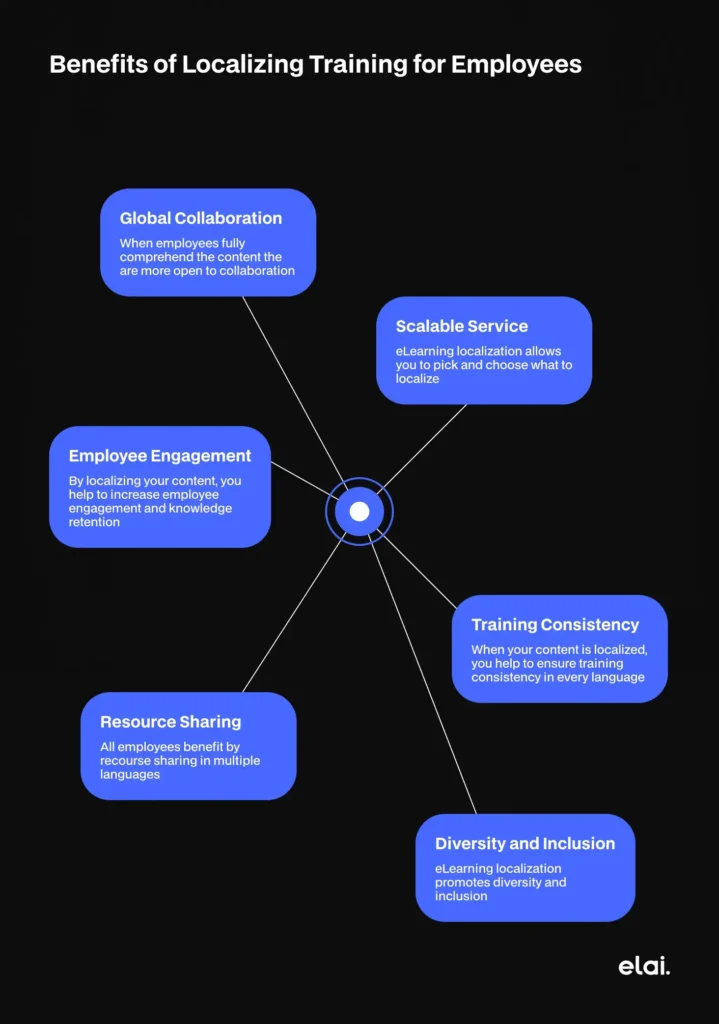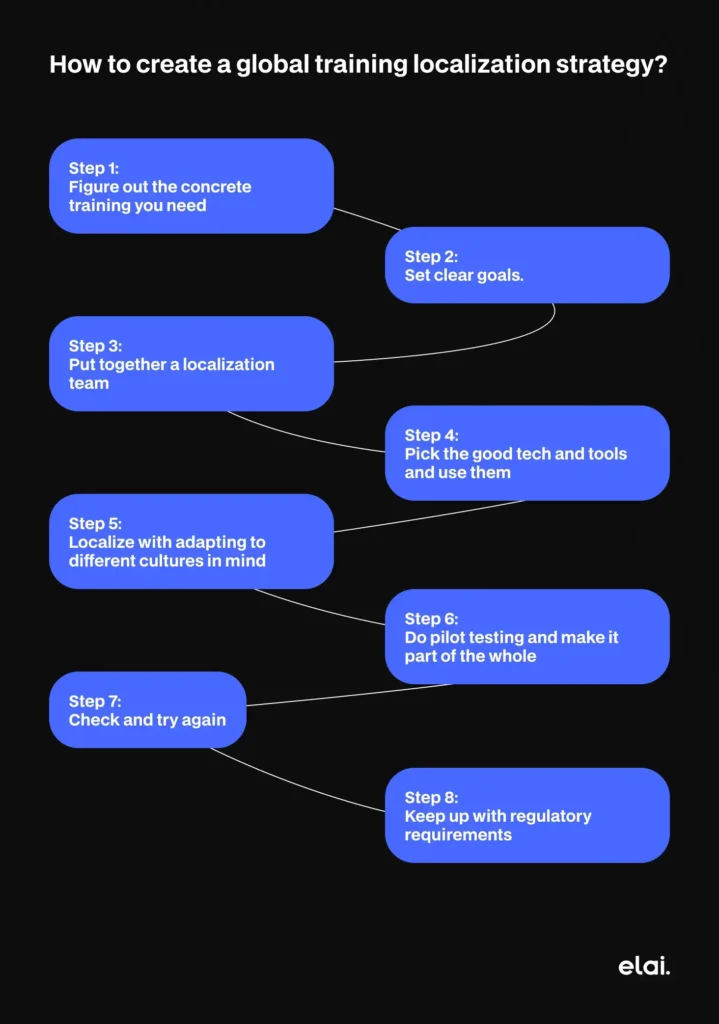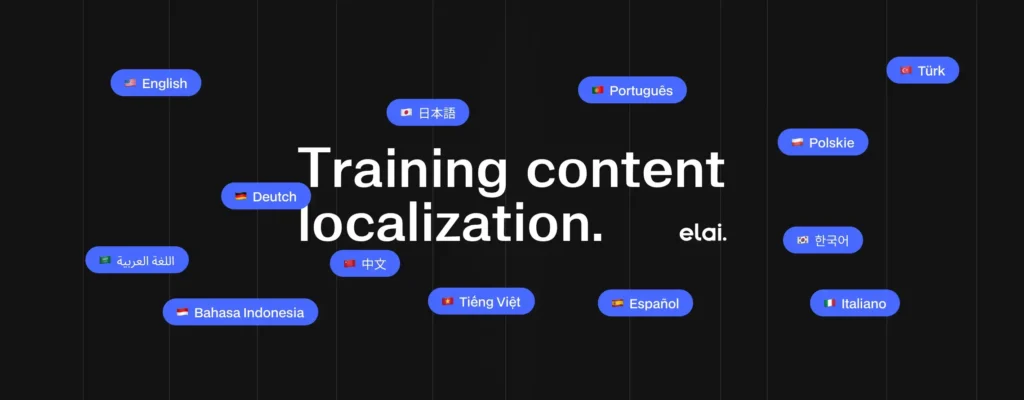These days, companies may find clients and employees all around the world, thanks to globalization. When it comes to training, this poses a hurdle. People from various nations may not have a common language, and there may be substantial cultural differences as well. Localizing content is useful in this regard.
All across the world, offices of multinational firms are being updated with the latest software or new policies. Training materials developed in the headquarters’ language may not be understood or, worse, may not work at all in other locations unless they are localized. This gap is filled by content localization. The lessons are tailored to each learner’s level by taking into account local slang, cultural norms, and even law requirements. To do this, a group of linguists and subject-matter experts work together to make the content correct and interesting for the audience.
Paying close attention to detail is what makes the localization of corporate training content so fascinating. To make sure they fit in with the local culture and background, not only are the words modified, but the pictures, examples, and case studies are also adjusted. Attention to detail like this aids in creating a setting where learners feel comfortable and at ease, which in turn boosts their ability to understand and remember what they’ve learned. Consequently, translation and localization are essential to every successful staff development program in today’s increasingly multinational business environment. It’s a great way to bring together different types of learners and provide them access to a shared, personalized knowledge base.
The importance of localizing training courses for employees
As businesses expand abroad, the employees are becoming more and more different, both in terms of language and cultural norms and traits. In this case, training localizing tools is important to make sure that all workers, no matter where they are in the world, get the same effective training. Localizing training for employees to close the gap between global goals and local execution is one way for companies to make sure that their foreign employees are in line with their goals, values, and operational standards. This alignment is necessary to make sure that the company’s brand stays true and consistent across multiple areas.
Following local laws and rules also requires that business training be tailored to the area. Each country has its own rules about employment, safety, and things that are specific to a business. Localized internal training programs make it less likely that employees will get in trouble with the law for not following these regional rules by ensuring they are aware of them. This is especially important in fields like medicine, manufacturing, and banking, where rules can vary a lot from country to country. By showing they are committed to doing business in a moral and legal way, corporate training localization helps companies build credibility and trust with local staff and government agencies.
Lastly, localizing training courses shows that a company cares about its employees’ growth and well-being. When training tools are made to fit the staff’s language and culture, they become more interesting and easy to understand. This helps you understand and remember more. Workers are more likely to feel valued and loved if they see that their boss is trying to understand and respect their language and cultural backgrounds. This not only makes the training more useful but also boosts morale and loyalty among employees, which are two important factors that affect job satisfaction and efficiency. When you look at it all, localization strategy is an investment in the most important thing a company has: its employees.
Benefits of localizing training for employees
Similar to a well-fitting suit, localizing employee training enhances the comfort of the wearer. Businesses can make the workplace more welcoming and productive by tailoring localizing strategies for internal training. This way, workers can understand the material and connect with it more deeply. Being able to adapt global training localization strategy to the specific needs of a multicultural workforce gives companies with a global footprint a big edge over their competitors.
The following are some of the most significant benefits of localizing staff training:
Better learning and retention: Training program localization significantly improves employees’ comprehension and capacity to remember the information since they are better in line with their linguistic and cultural backgrounds. Every worker at the company, regardless of nationality, has an equal opportunity to level up in their career because of this customized approach. Workers will engage in training easier if the content is applicable to their personal backgrounds and cultural norms. Localization may make training more engaging and participatory, which raises participation and fosters a sense of community at work.
Enhancements in performance: Employees who are more involved in the work and who understand the subject better are more likely to apply what they have learned in practical settings, which improves output. Employees who receive customized training acquire the abilities and confidence to advance the company toward its global objectives.
Cultural sensitivity and inclusion: Localized training demonstrates that an organization supports staff diversity and is dedicated to being considerate of and inclusive of other cultural backgrounds. The company’s culture is strengthened, and morale increases when employees feel valued and accepted for the different experiences and points of view they bring to the table. Localization makes sure that the main ideas and messages of corporate training are communicated in a way that workers all over the world can understand and find useful while still staying true to these elements.
Finding this delicate balance between local consistency and global relevance is essential to the success of any worldwide organization.
To put it briefly, the localization process is a conscious attempt to value and maximize the diversity of the global workforce, not only a practical or legal necessity. Companies that sponsor local training initiatives that assist individuals in realizing their full potential can foster a more hospitable, dynamic, and productive work environment.

Challenges of training courses localization
Imagine that you are at the edge of a huge forest, and each path leads to a different culture and linguistic world. At this point, localizing a training course is hard. Idioms and humor, those strange words that make people laugh in one language but may be difficult to understand in another — are the first problems that come to mind. Localization experts have to find ways to translate these parts so that they make sense in the new society, just like a traveler without a map. They have to make sure that the essence of the training doesn’t get lost in translation. There is a fine line between being clear and being sensitive to other cultures. If you make even the smallest mistake, it could lead to confusion.
A lot of technical terms and industry-specific words are also problematic to understand because they don’t have straight translations into other languages. This problem is like trying to read an old script without a Rosetta Stone. Subject matter experts will have to come up with new ideas and change things to make sure that the translated content stays correct and easy to access. The experts have to find their way through the maze and make sure that the training follows the rules and laws in each country. This makes the process of localization like a puzzle with many pieces that need both accuracy and creativity.
Lastly, the internet world makes things even more complicated. There are different screen sizes and technological systems, so the problem isn’t just cultural or linguistic. It’s also technical. Like architects who design buildings to survive the different climates of different areas, localization teams have to make sure that training classes are appropriate for language and culture and flexible in terms of technology. To do this well, you need to be both technically skilled and creatively smart, so that the training gets its audience and really engages them, no matter what kind of digital world they live in.
How to create a global training localization strategy
To make a global training localization strategy, you need to carefully plan, be sensitive to different cultures, and know what your employees’ different needs are.
Here is a step-by-step plan:
Step 1: Figure out the concrete training you need
Figure out the scope: See what training tools must be translated into your language. This could include tests, e-learning classes, books, and videos.
Know the target audience: Find out about the people that experience your training — the languages they speak, where they come from, and how they learn best.
Check out if the material is appropriate for different cultures: Make sure ithat the content doesn’t include references or cultural biases that will not work good with people from other backgrounds.
Step 2: Set clear goals
Write down your plans: How do you want your custom training to help you? Some goals that could be set are to get learners more interested in learning, to finish the course, or to do better on tests.
Set Goals and Measurements for Success: Figure out what you will use to judge how well your localized training programs are working.
Step 3: Put together a localization team
Pick the Right Partner: This team could have both internal resources with experience in localization and outside partners, such as translation services, culture consultants, and companies that make technology for localization.
What are the roles and duties? Make sure that everyone on your team knows what their job is and that you have experts in translation, instructional design, project management, and quality testing.
Step 4: Pick the good tech and tools and use them
Video localization: Pick authoring tools that work with a lot of languages and make it easy to change material. Platforms like Elai.io which use the technologies of AI video generation, can become one of the best tools to change the material quickly. By using video content localization with Elai.io, you can switch from one language to another faster without the need for additional instruments.
Translation Management Systems (TMS). Use a TMS to speed up the translation process and make sure that all of the materials are translated the same way.
Step 5: Localize with adapting to different cultures in mind
Take content and translate it: Don’t just translate words word-for-word; change the content to fit the culture, the rules of the area, and examples that are specific to the market.
Looks and design: Make sure that the colors, symbols, and images you use are appropriate for each group you want to reach.
Step 6: Do pilot testing and make it part of the whole
Before a full rollout, do pilot tests with a small group of your target audience to get feedback and make any changes that are needed.
Integration: Make it easy for all of your targeted employees to access the elearning localization by integrating it into your current LMS (Learning Management System) or other training platforms.
Step 7: Check and try again
Ask for Feedback: Use quizzes, polls, and analytics to find out how engaged and knowledgeable your students are.
Always Get Better: There is no such thing as a one-time localization job. Use feedback and data on success to keep improving and adding to the training materials.
Step 8: Keep up with regulatory requirements
Keep up with the law: To make sure that your training stays legal, stay up to date on the laws and rules that apply in each area.
Documentation: Keep detailed records of your translation and adaptation processes so that you can be held accountable and look back on them later.
If you follow these steps, you can make a global training localization of elearning content that meets your organization’s goals, improves learning outcomes, and ensures the training is relevant to different cultures.
By carefully adapting their training to local needs, businesses can get the most out of their global talent pool. Moreover, they can ensure that all of their employees, no matter where they come from, can add to and benefit from the company’s overall success. As we look to the future, we can be sure that the constant evolution of localization strategies will have a big impact on the next generation of business training, making it easier to access, more interesting, and more useful than ever.

Finally, the path to successful localization of training shows how important it is to understand, change, and come up with new ideas when dealing with global diversity. It means a promise to do more than just cross borders; it means removing the things that stand in the way of people knowing each other and growing together. The benefits for companies that are willing to go on this journey go beyond just following the rules and being efficient. These benefits go to the heart of what it means to be a global community—one that learns and grows together and eventually thrives together.

